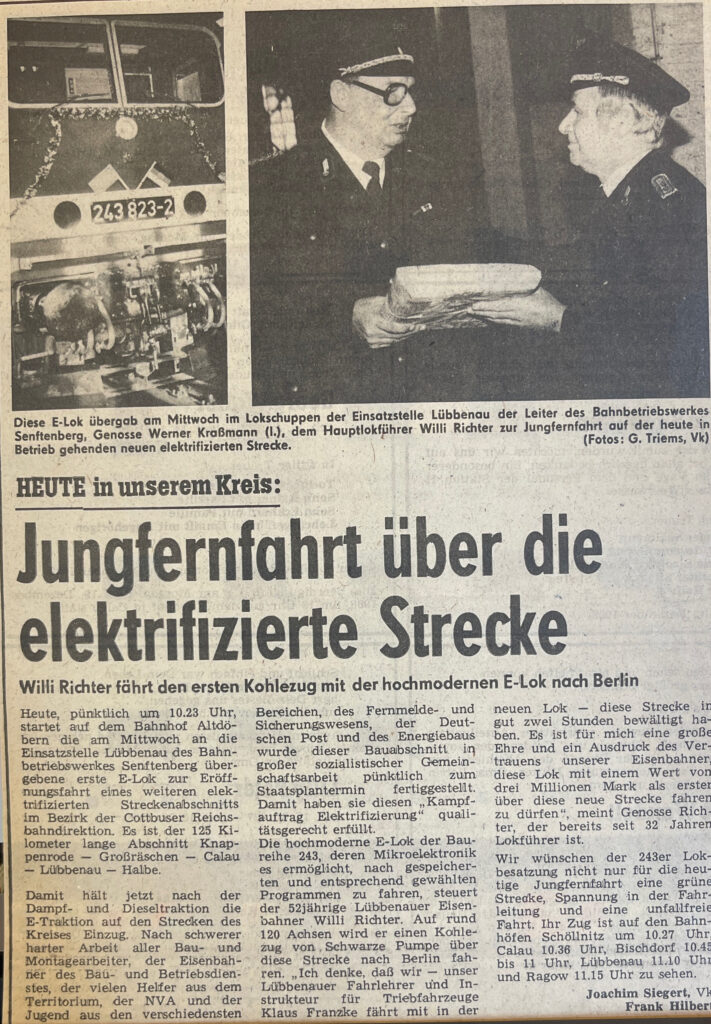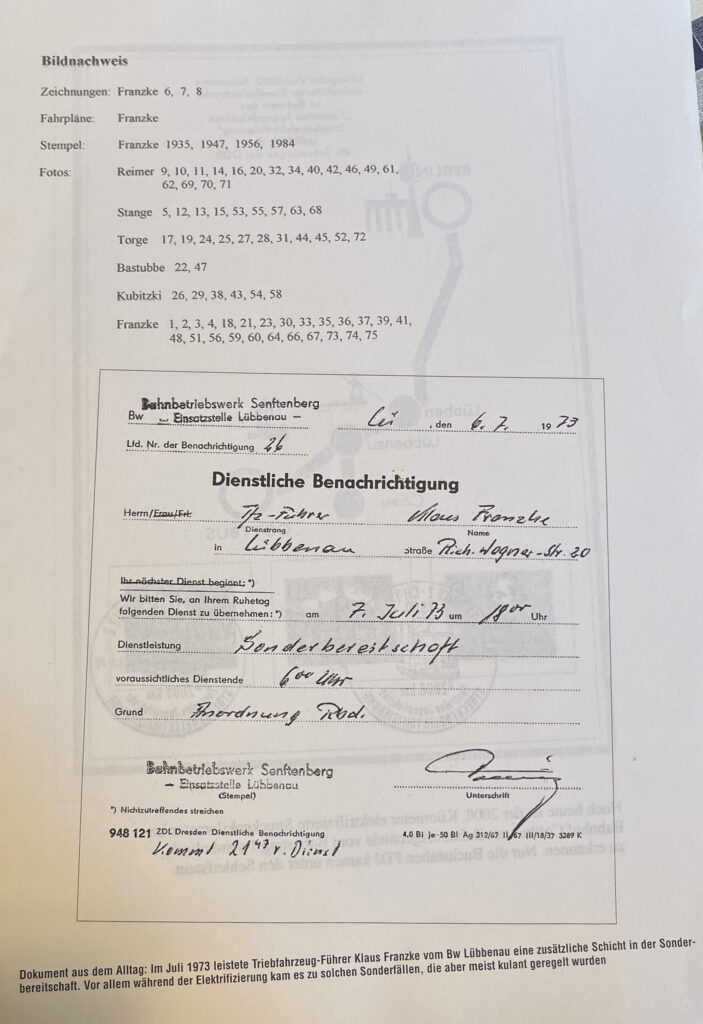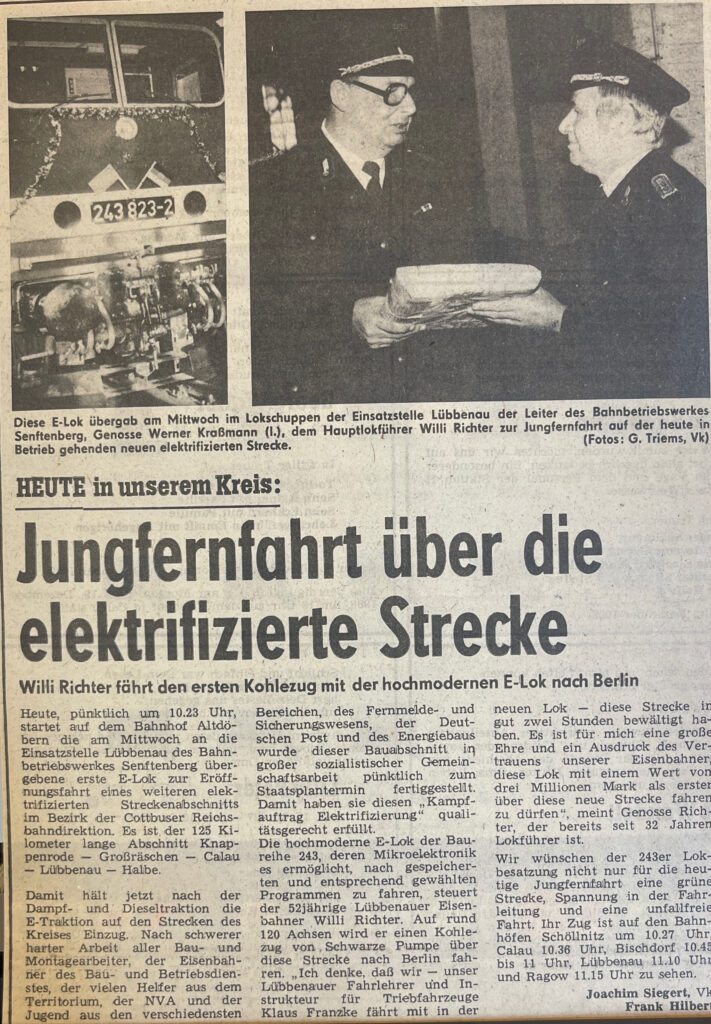Railroad memories – Lübbenau and its locomotive depot
135 years ago, in 1890, an engine shed was inaugurated at Lübbenau station, initially for eight locomotives. This became absolutely necessary because steam trains, whose locomotives had to be supplied with coal and water, were now running regularly on the Berlin – Görlitz line, which was built in 1866. They were also maintained and repaired here and kept in reserve as traction units.
Klaus Franzke is one of the Lübbenau railwaymen who remembers working together successfully. He was a railwayman with heart and soul, a caretaker, as they say today. Born in East Prussia, he arrived in Lübbenau with his parents at the age of one after an escape full of privation. After finishing school, he actually wanted to become a forester, but his railwayman father steered him in a different direction: his dream job was to be a train driver – and he became one. At the Reichsbahnausbesserungswerk (RAW) Cottbus, he learned the trade of engine fitter, which was so different from being a forester in the fresh air and green surroundings. Dust, ash, oil and mostly a dark workplace on and in the black steam locomotives were now his everyday surroundings. But this was the only way he could get to know the steam locomotives from the ground up, later training as a stoker and then as an engine driver. In 1964, as a very young locomotive driver, he was already driving the class 55s in shunting service, the 38s in passenger train service and the 43s and 52s in freight train service.
His extensive experience with the various types of locomotives and a qualification later enabled him to become a “driving instructor”. Now working at the Lübbenau depot, further tasks were added. Until the closure of the plant in 1993, he was head of the traction unit operations department. Steam locomotives hardly ever ran on the lines from Lübbenau, but they were kept as reserve locomotives for a while, but were finally retired in 1979. The age of diesel locomotives had dawned and was replaced by electric locomotives after relatively few years. But first of all, diesel locomotives from Soviet and GDR production were used. The V 200 from the former brother country was also known as the “Taiga drum” because of its operating volume and was mainly used in freight train service. The GDR locomotive V 180 from Babelsberg was primarily used for passenger services.
Diesel locomotive operation
Under the headline “Service on a V 200 – Fourteen railwaymen retrained”, the Lausitzer Rundschau reported on the start of the traction change in Lübbenau: “February 1, 1969, 4.41 a.m., at the Lübbenau depot. Brigade locomotive driver Comrade Felix Niederhof and locomotive driver Klaus Franzke report to the locomotive management for their first duty on a class V 200 diesel locomotive. The foreman, Comrade Stephan, welcomes them and appeals to them to drive trouble-free and accident-free at all times. This is an important contribution to fulfilling the transport tasks in the 20th anniversary year of the German Democratic Republic.(LR from 18.02.1969)
Klaus Franzke: “After this first successful trip, Felix Niederluf and I were welcomed with flowers at Lübbenau station by the stationmaster Stephan and the BGL chairman Heinze. What is often seen today as a propagandistic or ideological display was common practice at the time: People were proud of each other’s achievements – and in return there were flowers and a handshake!”
Electric locomotive operation
On December 17, 1988, the electrified section Halbe – Lübben – Lübbenau – Calau – Großräschen – Senftenberg was opened. The first train was pulled by 243 823, manned by Lübbenau locomotive driver Willi Richter and traction unit instructor Klaus Franzke. The train departed from Spreewitz/Schwarze Pumpe station at 10.23 a.m. and had Berlin as its destination.
In the meantime, electric operation has become an integral part of everyday life. However, this meant that the Lübbenau depot lost its function, which had lasted for over a century. While the steam locomotives and later the diesel locomotives were still maintained and repaired there, this was no longer planned for the electric locomotives. This would have required the entire plant, which now has 18 locomotive bays, to be converted at a very high investment cost. Only the turntable was partially spanned with contact wire so that electric locomotives could be turned if necessary.
Around 1980, 225 railwaymen and women were employed at the Lübbenau depot, a number that rose to 300, but then fell dramatically after reunification. From then on, the locomotives were serviced in Senftenberg, and the Lübbenau works also became increasingly less important as a locomotive depot.
Klaus Franzke was one of those who literally switched off the lights and locked the gates on December 31, 1993. The rest of the workforce gathered at the turntable one last time, also to listen to speeches of thanks and to take a farewell photo. Klaus Franzke was subsequently given further responsible tasks, most recently at DB Regional Management North East in Berlin, before retiring.
The Lübbenau buildings and facilities fell into disrepair over time – but the site is now about to be resurrected: the “Spreewälder Gurkenwelt” will move in here in a few years after extensive construction and reconstruction work.
Peter Becker, 17.09.25


View into the former engine shed:
